Thursday 28 February 2019
Twitter is testing a reply moderation feature for threads
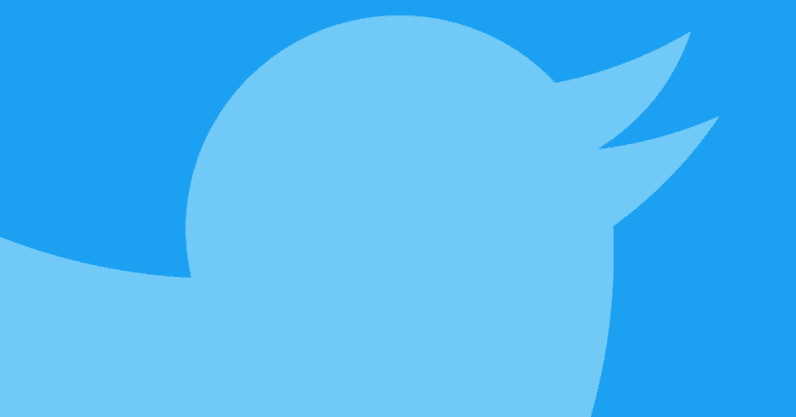
Jane Manchun Wong, a security researcher who has a history of revealing yet-to-launch features through reverse engineering, tweeted today that Twitter is testing a “replies moderation” tool. Twitter is testing replies moderation. It lets you to hide replies under your tweets, while providing an option to show the hidden replies pic.twitter.com/dE19w4TLtp — Jane Manchun Wong (@wongmjane) February 28, 2019 According to Wong, this feature allows users to hide replies under their tweets, while providing an option to show the hidden replies to other users. Since this was announced, multiple Twitter users have raised concerns over what this means for the…
This story continues at The Next Web
Or just read more coverage about: Twitter
from Social Media – The Next Web https://ift.tt/2IHYq5E
via IFTTT
Wednesday 27 February 2019
The 3 Best Copywriting Formulas for Email Marketing

Copywriting Formulas for Email Marketing
Formula 1: F-A-B
You understand your product or service from the inside out, but it can be tough to communicate all the important details about it in an email or two. Plus, you run the risk of losing your reader’s interest if you drone on too long about your product features. Yes, it’s important to explain the features of your product — but where the magic happens is when you connect those features with the advantages and benefits they bring to your customers. With the F-A-B formula (which stands for Features, Advantages, Benefits), you can touch on your product’s bells and whistles, but you focus on why a person would find your product beneficial. Here’s the breakdown:- Feature: Briefly explain the elements of your product. Keep it short and sweet.
- Advantages: Highlight why these features are unique and how they can make a difference in your customer’s business, life, etc.
- Benefits: Showcase the value of your product and how it can solve your customer’s problems.
{Insert feature} will help you {insert advantage} so you can {insert benefit}
Example of F-A-B in a Tweet: Our wireless Smart Robot Vacuum will clean your pet’s hair off floors and carpets, so you don’t have to spend time chasing down hairballs.
These same principles can be used in subject lines or stretched out to serve as body copy. For the latter, you may expand on the advantage and benefits in multiple paragraphs to really drive the value home.Formula 2: P-A-S
It may not come as a surprise that P-A-S made our list, but it’s a tried-and-true copywriting formula that works for just about every scenario. In fact, marketing legend Dan Kennedy calls it the most reliable sales formula ever invented. Let’s take a look at how it works:- Problem: State your audience’s issue.
- Agitator: Agitate the problem by talking about why it’s a problem in the first place.
- Solution: Solve your audience’s issue by presenting your product or service as the solution.
Pet hair everywhere? Spending more time cleaning up pet hair means less time for the things you want to do — like napping or watching Netflix. You could spend time sweeping every day, or you could let our Smart Robot Vacuum clean it up FOR you.
The P-A-S formula is excellent for subject lines, but it’s also a fast and easy way to explain your value proposition in a quick way. Many email marketing geniuses use this formula in their own emails. Here’s an example from Paula Rizzo, an AWeber user and a TV producer who has an entire side business called The List Producer. Through this business, she helps customers stay organized with various checklists and courses. Subscribers who sign up for Rizzo’s email below have stated they’re feeling a lack of control in their digital world. Their inbox is overflowing and they can’t keep up! In her first email, Rizzo welcomes her new subscriber, tells them a little bit about her business, and then launches into agitating their problem. The agitation section is shown below: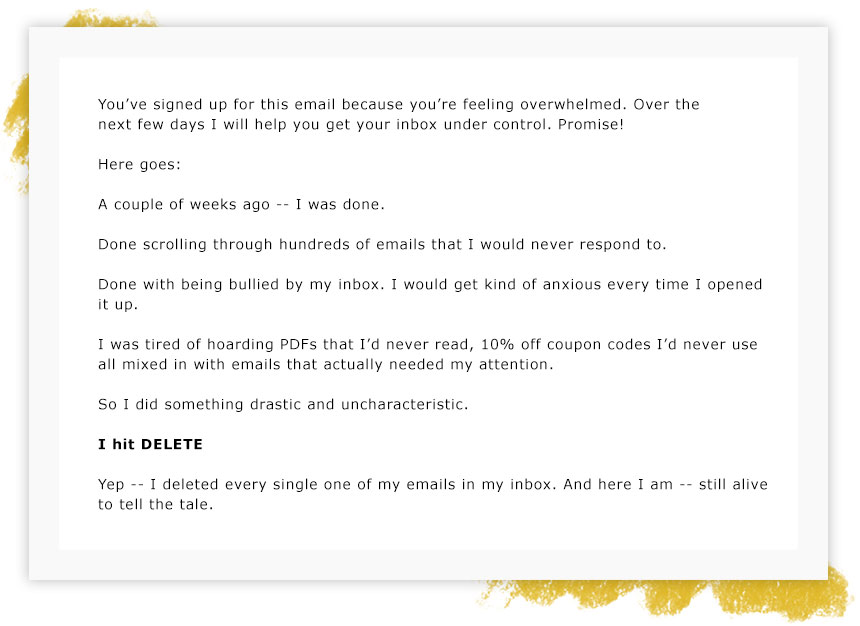 Then, Rizzo hits the reader with a solution: a paid course “Take Back Your Inbox: Stop Drowning in Unread Messages, Respond Quicker and Finally Achieve Inbox Zero.” (Check out all that’s included in her $47 course.)
Then, Rizzo hits the reader with a solution: a paid course “Take Back Your Inbox: Stop Drowning in Unread Messages, Respond Quicker and Finally Achieve Inbox Zero.” (Check out all that’s included in her $47 course.) 
Formula 3: A-I-D-A
A-I-D-A is arguably one of the most-used copywriting tactics of all. First, here’s what it stands for:- Attention: Catch the reader’s eye.
- Interest: Pique their interest with a compelling setup.
- Desire: Make them crave the thing you’re offering.
- Action: Tell them how to get the thing.
Stretch it out!
You can use these copywriting formulas in one email — or you can expand it over a series of automated emails. For instance, with P-A-S, you could use it over the following 5-email series: Email 1: Introduce the reader’s biggest pain point Email 2: Agitate the problem Email 3: Really get in there! Agitate the problem some more. Start to hint that there may be a solution for their issue... Email 4: Offer the solution — your product or service! Email 5: If the reader doesn’t convert, you can offer a coupon or special incentive to buy. Digital marketer gurus like Amy Porterfield, Henneke Duistermaat, and Jeff Walker have used similar email series when they launch a new online course or product.Additional copywriting tips
Once you find a copywriting formula that works best for you, keep these tips in mind as you begin writing. Avoid jargon Using words that your customer may not understand is a quick way to lose their interest. Make sure they understand your message and what value you can provide them. Nail the subject line It’s been said a million times, but it rings true. Having a solid subject line that piques the interest of your subscribers will ensure the email content you worked so hard to create has a chance to be seen. Be sure to deploy A/B testing to find your strongest option. Related: 6 Email Split Tests You Can Set Up in 1 Minute Be conversational Being personable with your copy is a great way to engage with your customers and show them that there are real humans behind your brand. Conversational tones not only make your brand sound more relatable, but it’ll ensure your customers understand what you’re saying, too. For more email copywriting advice, check out our full list of copywriting tips.Formulas save time and maximize ROI
Copywriting formulas are an excellent way to make sure you communicate your message clearly and present it in a way that will be most receptive to your audience. Different formulas work for various products and messages, so keep testing and tracking what you learn from each formula use. Ready to see a greater ROI on your email marketing? Sign up for AWeber today or contact a Customer Solutions member. (Our team is available 24/7 at our Pennsylvania headquarters!)The post The 3 Best Copywriting Formulas for Email Marketing appeared first on Email Marketing Tips.
from Email Marketing Tips https://ift.tt/2Nu5MYY
via IFTTT
Tuesday 26 February 2019
Facebook’s global content moderation fails to account for regional sensibilities

Over the past year, Facebook’s biggest challenge has been moderating billions of posts every day in more than a hundred languages. It’s proven almost impossible to maintain a balance between what is deemed as “hate speech” and “free speech” since social media is global, but our perception of “free speech” is determined by region. During the TechChill conference in Riga last week, David Ryan Polgar, a Tech Ethicist and founder at All Tech is Human, explained the challenges platforms like Facebook and Twitter face when it comes to moderating what they believe to be “hate speech.” For hundreds of years, it was…
This story continues at The Next Web
Or just read more coverage about: Facebook
from Social Media – The Next Web https://ift.tt/2GKREu7
via IFTTT
Monday 25 February 2019
‘The Gyllenhaal Experiment’ shows where redditors go wrong in spelling celebrity names

In more than 600,000 attempts at spelling actress Scarlett Johansson’s name, fewer than one-in-three were successful. In terms of absolute certainty, all we can be sure of is that most would get the first five letters correct. Called “The Gyllenhaal Experiment,” after both Jake and Maggie Gyllenhaal — both actors with hard-to-spell names — the study sheds light on some of the most common spelling errors on Reddit. The data gets pulled any time a redditor uses “(sp?)” — a common method used to indicate that the poster is unsure of spelling — after an attempt to spell a word, or…
This story continues at The Next Web
from Social Media – The Next Web https://ift.tt/2SXCFDF
via IFTTT
Thursday 21 February 2019
Wednesday 20 February 2019
Social media listening: Your launchpad to success on social
This post Social media listening: Your launchpad to success on social originally appeared on Sprout Social.
from Sprout Social https://ift.tt/2GQK28m
via IFTTT
Tuesday 19 February 2019
How social listening powers real connection with your customers
This post How social listening powers real connection with your customers originally appeared on Sprout Social.
from Sprout Social http://bit.ly/2Ta6VdP
via IFTTT
Monday 18 February 2019
Uganda loses 5 million internet users as a result of Social Media Tax
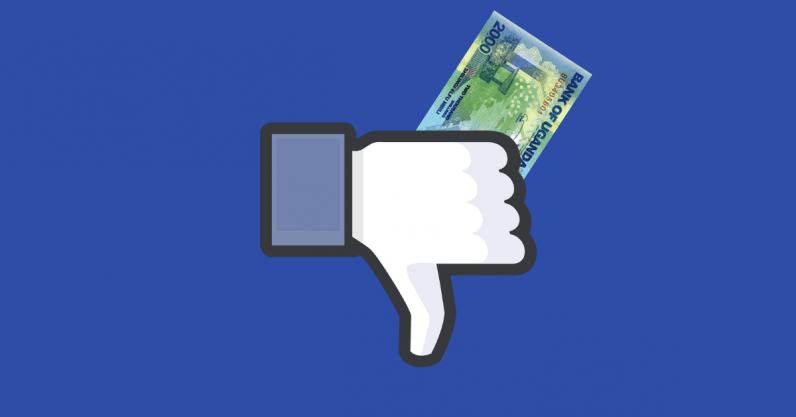
Half-way through 2018, Uganda introduced a Social Media (OTT) tax which required Ugandans to pay a tax if they wanted to access services such as Facebook, Twitter, WhatsApp, and many others. It turns out, based on released data by the Uganda Communications Commission (UCC), the tax has had a significant impact on the number of internet users in the East Afrikan country resulting in a drop of 3 million internet users over a 3 month period. What is also interesting when one looks at the data released by the UCC is that approximately only half of the internet users in Uganda were actually paying the Social…
This story continues at The Next Web
from Social Media – The Next Web http://bit.ly/2X85jjA
via IFTTT
Friday 15 February 2019
Using social media to measure air pollution’s psychological toll

People are less happy on days when the air is more polluted, according to an analysis of 210 million posts on the Chinese social media site Sina Weibo. Researchers have suspected air pollution takes a psychological toll generally, and dirty air due to industrialization, coal burning, and motor vehicles has become a drag on well-being for Chinese city dwellers. But these effects are difficult to measure. That’s where Weibo, the Chinese version of Twitter, comes in. An international team of researchers analyzed posts made between March 1 and November 30, 2014 and geotagged in 144 different Chinese cities. They used specialized…
This story continues at The Next Web
from Social Media – The Next Web http://bit.ly/2tmtgpF
via IFTTT
Thursday 14 February 2019
The new period emoji is a first step in ending period shame
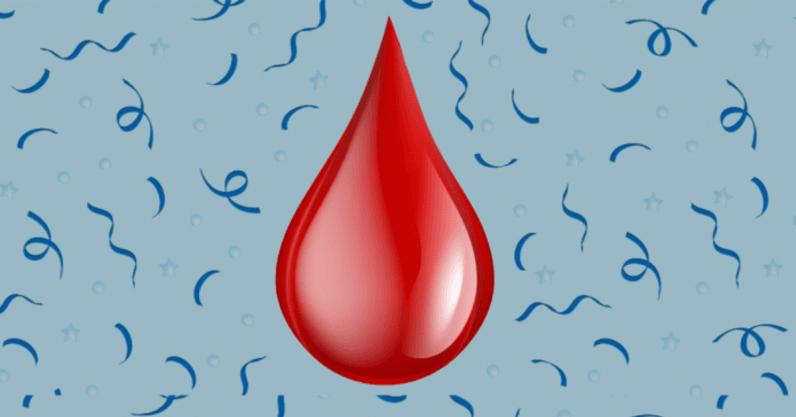
Emoji has become a universal language of its own, but up until now there wasn’t one for people to say “I’m on my period” — and that’s more important than you might think. This bloody brilliant news came earlier this month when the Unicode Consortium (the official body that manages emoji worldwide) confirmed in a blogpost that they had approved 59 new emoji designs, including a “drop of blood” that will be added to our emoji catalog in spring this year after more than 55,000 people voted for it. This is all thanks to a girls-focused development charity, Plan International UK and…
This story continues at The Next Web
from Social Media – The Next Web http://bit.ly/2DE8o29
via IFTTT
Wednesday 13 February 2019
Tuesday 12 February 2019
Facebook lets you search for pictures of your female friends, but not your male ones

A Belgian security researcher has found an unusual quirk in Facebook’s search function. Facebook lets you search for photos of your female friends, but refuses to play dice if you want to look up pictures of your male friends. The bizarre find was discovered this weekend by notorious Belgian white-hat hacker Inti De Ceukelaire. Meer zelfs: bij het opvragen van foto's van je mannelijke vrienden, gaat Facebook er van uit dat je foto's van vrouwen wou gaan bekijken. *Facepalm* pic.twitter.com/lIOBtAnvla — Inti De Ceukelaire (@intidc) February 11, 2019 TNW has managed to replicate the glitch across several Facebook accounts. When…
This story continues at The Next Web
Or just read more coverage about: Facebook
from Social Media – The Next Web http://bit.ly/2I78DYU
via IFTTT
10 Steps to Creating a Landing Page That Converts

Step 1: Establish your USP
Your USP (Unique Selling Point) is the thing that sets you apart from the competition and the reason why people will choose you over everyone else. Studies show that you have less than 15 seconds to capture someone’s attention when they land on your website. That’s how long they’ll stick around before deciding whether what you’re offering is right for them. So you need to impress them, quick. Define a strong, value-driven USP and build your landing page around it. You can do this with headlines and images (we’ll talk more about those soon), or by including a value proposition in your landing page copy. A value proposition is a key component of your small business marketing strategy, and shows the user what they’ll gain when they take action, whether that be filling out a form or making a purchase. Value propositions include:- Showing how your product or service compares against a well-known competitor
- The ROI that can be achieved
- The monetary value of the product and the saving that can be made by signing up now
- The success that can be achieved
- Making it clear that your offer is free
- A guarantee

Step 2: Keep the design clean and simple
Everything about your landing page should be geared towards getting the user to complete the transaction. This means removing anything that might draw their attention away from your offer. Make your landing page full width and height, and remove navigation features. This isn’t to say you should scrap scrolling completely, but you should take away any visible arrows or buttons that encourage it. Make the most of white space too. Sometimes, what you leave off the page is as powerful as what you include. White space removes congestion and gives the brain space to think. It also forces the eyes to focus on your offer. Take a look at how the AWeber homepage keeps things simple and clean:
Step 3: Create headlines that hit home
A landing page will live or die on the strength of its headline. This what grabs a visitor's attention and compels them to find out more about your offer. Studies show that as many as 80% of people will read the average headline, but only 20% will read the rest of the copy, so it’s important that you nail this part of your page. A good headline should:- Immediately grab the attention of your visitors
- Tell the visitor what your offer is about
- Be short and sweet

As does Robinhood.
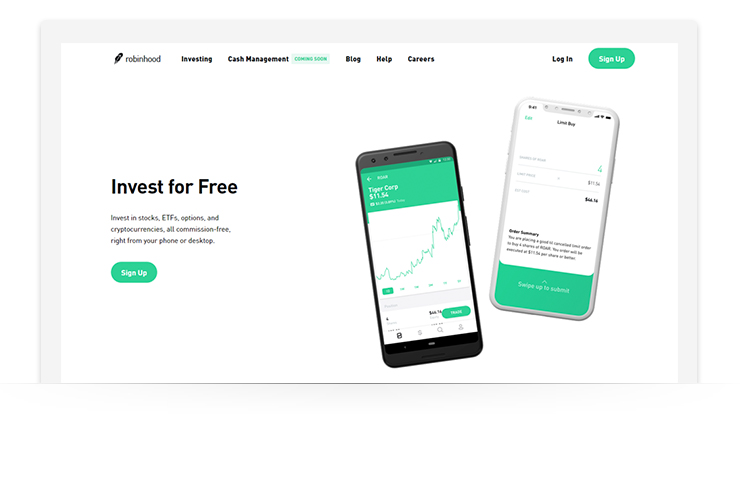
Step 5: Grab attention with images
Images are a huge part of landing pages that convert. They’re the first thing that catches the visitor’s eye before they read the headline.
Images are processed 60,000 times faster than text by the brain, so what the visitor sees will influence their immediate opinions about your brand and offer.
Like headlines, use imagery to grab attention. Make them relevant to your product or service.
- If you’re offering a product, your imagery should be of the product
- If you’re offering a service, your imagery should relate to what the service is in a way that paints a positive picture in the mind of the user
Remember that you don’t have long to make a good first impression. Make sure images are large and high-quality. Try to stay clear of stock imagery — you don’t want to show visitors something they may have already seen.
Teambit, an employee engagement and performance management platform, is a great example of imagery done well — original illustrations used to capture attention and promote its service:
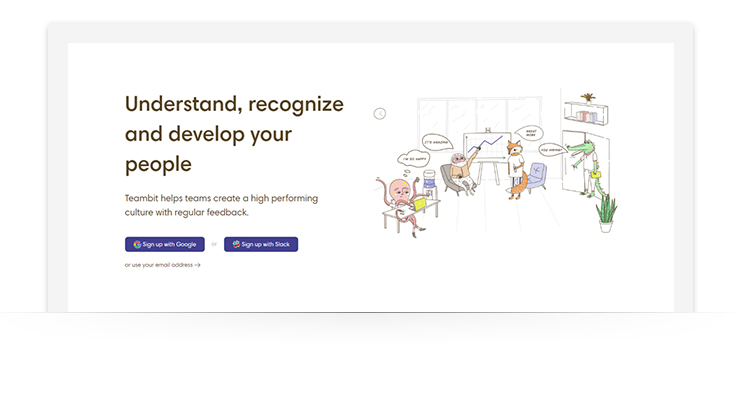
Step 6: Talk up the benefits (but not too much)
Including benefits on your page is a way to reassure and persuade visitors that are on the fence. They back up your USP and headlines, and provide users with more information about what you offer.
When it comes to writing out the benefits of your offer, focus on clarity. Clearly explain how what you’re offering can solve the user’s problem. But do it in as few words as possible.
According to MarketingProfs, landing pages with more than 800 words have a 33% lower conversion rate than pages with less than 200 words. Bullet points are a great way to keep things concise and make benefits easily digestible for the user.
Of course, not everything has to be written. Video is a powerful persuasion tool. Research by Eye View Digital shows that using videos on landing pages can increase conversions by 86%.
Codecademy uses both video and copy for its benefits, dedicating a full section of its landing page to the former:
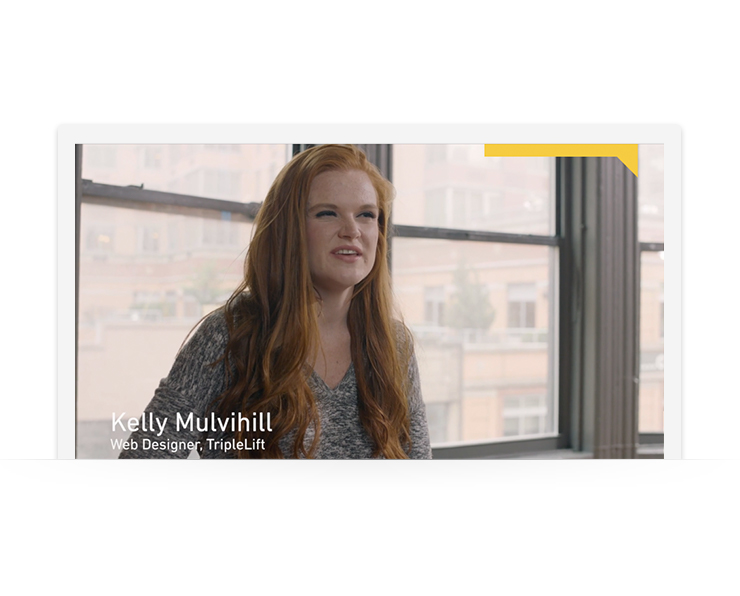
Step 7: Add social proof
88% of consumers trust online recommendations as much as personal ones. If you’ve got people that have used your product or service and are happy with it, use their feedback to your advantage.
Including social proof is one more way to convince visitors that your offer is as good as you say it is. It can be added to your landing page in a number of different ways.
- Customer case studies or testimonials
- Recommendations from influencers or industry experts
- Number of users
- Certifications from trustworthy industry bodies
- Showing how many of the user’s friends use your service
By the time users get to the social proof section of your landing page, you’ve already captured their attention and interest. What they’re looking for now is confirmation bias — a reason to back up what they’re already feeling.
Basecamp does this well by combining number of users and testimonials for some strong social proof that supports the strength of its offer:
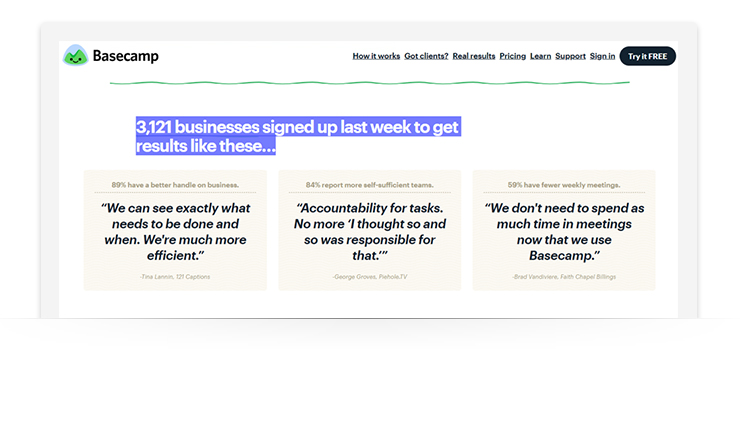
Step 8: Include contact information
Contact information tells the visitor that you’re a real company. It lets them know that there’s someone behind the landing page, which increases trust.
Including a physical address and contact phone number is the most basic way of adding legitimacy. What those things don’t do, though, is encourage contact. If you want to be helpful to visitors, give them a way to get in touch online. There are three ways you can do this.
- Include a chat pop-up that follows the visitor down the page, making you available to answer any questions
- Include a contact form on the page
- Include a contact call-to-action that clicks through to a dedicated contact page
Step 9: Make calls-to-action strong and clear
Every element of your landing page is designed to get visitors to notice and click on the call-to-action.
Include calls-to-action throughout your landing page, placing them above the fold, at the bottom of the page and two or three times in between. In terms of how it should look, there are some standard rules to follow:
- Make it big enough not to be missed
- Always use a button. People are conditioned to expect a button, don’t throw a curveball at them
- Use a contrasting color that attracts the eye
- Use words that are valuable and actionable (e.g. “Get your Free Trial,” “Buy Now,” “Download Now,” etc.)
Unbounce places their call-to-action front and center where it's impossible to miss:
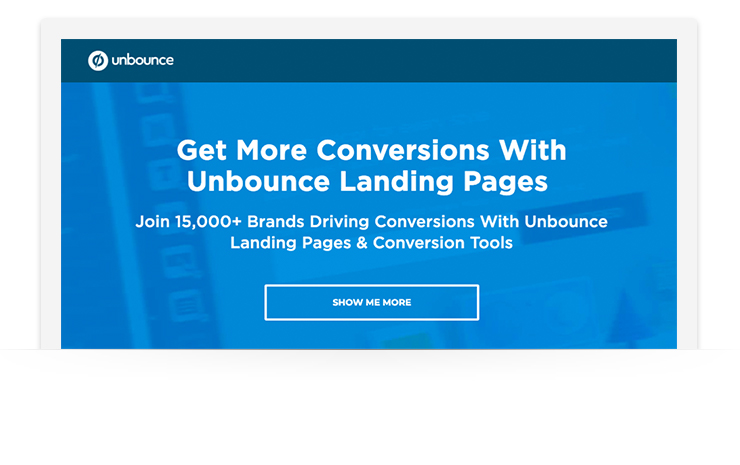
Step 10: Test, test, test
Landing pages are trial and error. Once you’ve created a page you’re happy with, don’t put it live and just leave it. Always monitor performance and iterate. Look at your analytics weekly and look at performance over time. Use heatmaps and scrollmaps to see how people are interacting with the page and use the information to improve.
If your page isn’t bringing in the number of leads or conversions you expected, tweak elements of the design or copy, or tinker around with the color and positioning of buttons.
Then, run A/B tests to see how the different pages perform against one another. From there, you’ll be able to take the best elements of both to produce a page that gives you bang for your buck.
Related: 6 Email Split Tests You Can Set Up in 1 MinuteConversions are only the first step
Your landing page converting is a sign that a) it’s working, and b) people are putting their trust in you to deliver on what you say. Repay trust and reward loyalty by emailing customers with content that adds value, personalized offers, and freebies, or letting them know when they left items in their cart. Every dollar spent on email marketing has an ROI of $44. Once a person has opted-in to your email list, use it to your advantage.
Related: How to Get Your First 50 Email Subscribers in 30 DaysNot sure what to include in your emails? Download 45+ free writing templates to learn how to craft emails like a pro.
About the author: With nearly a decade of digital marketing experience, Chandal has created content strategies for both the biggest and sometimes the most unexpected markets, while developing strategic relationships with editors and publishers. Chandal contributes to some of the highest authority industry publications, has been featured in industry events and is thrilled to be Acquisio’s Content Director.The post 10 Steps to Creating a Landing Page That Converts appeared first on Email Marketing Tips.
from Email Marketing Tips http://bit.ly/2SKEUJf
via IFTTT
Monday 11 February 2019
Justice Ginsburg made a public appearance last week — but the internet still thinks she’s dead

On Monday, the day before President Trump’s State of the Union Address, Supreme Court Justice Ruth Bader Ginsburg attended a performance celebrating her life at a museum in Washington — her first public appearance since December. It did little to convince the internet’s most morbid conspiracy theorists that she wasn’t dead. Justice Ginsburg, or RBG as she’s known to her fans on the internet, underwent surgery on her left lung in November to remove malignant nodules, a surgery that doctors say went well before declaring her cancer free — again. It was her third bout with the disease. In 1999,…
This story continues at The Next Web
from Social Media – The Next Web http://bit.ly/2N2RPRv
via IFTTT
How to mute spoilers on Twitter and Facebook
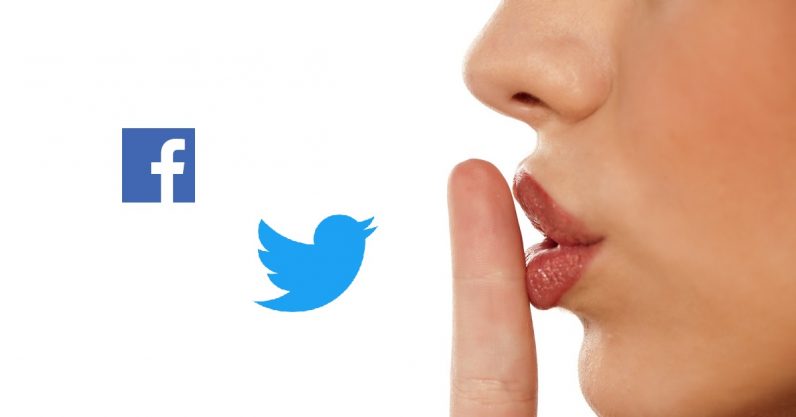
Welcome to TNW Basics, a collection of tips, tricks, guides, and advice on how to get the most out of your gadgets, apps, and other stuff. Spoilers have become a pitfall of modern life. They’re a first-world problem, perhaps, but still something that can ruin one of the few pleasures that make it worth facing another arduous cycle around this pitiless yellow star in the face of looming crisis, economic turmoil, personal struggles… Ahem. Yeah, spoilers suck. But as social media has bloomed into a medium for self-expression, you can hardly move without tripping over spoilers for whatever tv show, video…
This story continues at The Next Web
Or just read more coverage about: Facebook,Twitter
from Social Media – The Next Web http://bit.ly/2TLUMZq
via IFTTT
Thursday 7 February 2019
How to use Instagram collections like a makeshift Pinterest

Welcome to TNW Basics, a collection of tips, tricks, guides, and advice on how to get the most out of your gadgets, apps, and other stuff. Show of hands: how often do you use that button on Instagram that looks like a bookmark? If you don’t already use it, you should. With collections, you basically save any Instagram post into a Pinterest-style board with the theme of your choice. You can save your favorite pics, tasty recipes, fashion looks, or goofy stuff your friends post. Unlike Stories or regular posts, collections are private and only accessible to the collector. For example,…
This story continues at The Next Web
Or just read more coverage about: Instagram,Pinterest
from Social Media – The Next Web http://bit.ly/2GfK62g
via IFTTT
How To Create Your First Email Course or Email Challenge

The Solution
Developing a compelling email course or challenge can revitalize your digital marketing, boost your subscriber growth, and generate a ton of sales for your business. Email courses and challenges uniquely attract a relevant and eager audience by tapping into human psychology. Courses and challenges draw on our desire to learn, achieve goals, feel accomplished, and connect with a purpose. Not only is this strategy effective at growing your email list, it’s also a logical pre-purchase step for your prospective customers. People that engage with your course or challenge are primed to become perfect buyers for your paid products or services. The best part: As email automation tools like AWeber become more powerful, accessible, and easy-to-use, building a simple course or challenge is a breeze. In the following sections, you’ll learn:- the difference between a course and challenge
- how to choose the best option for your brand
- how to build your course or challenge using an email automation platform
- how to convert participants into paying customers
What is an email course?
An email course is a simple series of automated emails that deliver educational or instructional content. (See our newest course, Everyday Email. You get 30 tips in 30 days sent to your inbox. It's the MOST FUN way to learn email marketing. Ever.) We’re in the age of online courses, where successful entrepreneurs are making a living using robust, affordable, and accessible course platforms like Thinkific and Teachable. These platforms help you build, deliver, and sell text, audio, or video-based courses to your audience. Online educational courses are effective because they deliver valuable instructional content that people need to learn and grow. With an email course, you don’t need to pay for extra software or find a new service to learn. You’ll simply deliver your lessons by email. 💌 For example, you might offer a 1-week email course to your website visitors. When someone signs up, AWeber will automatically deliver a sequence of emails at a frequency of your choosing. This could be one email per day, or one every other day. It all depends on your course content. Here’s a quick view of how a daily course might look for someone selling a guitar lesson bootcamp: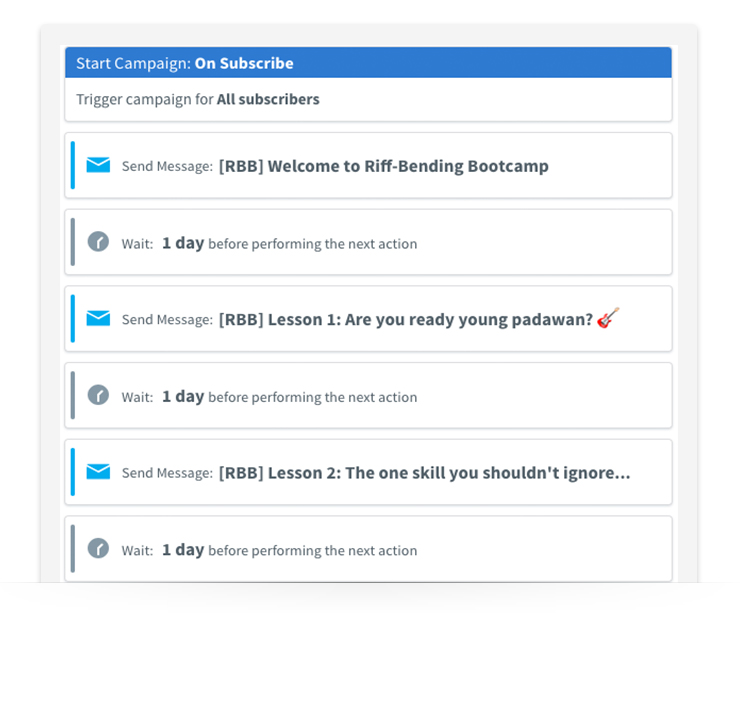 If your email course is free, you can use it as a lead magnet a.k.a. an incentive to invite lots of people to join your email newsletter list. Just let them know that by signing up for the course, they’re granting you permission to send them newsletters later. This is a great way to skyrocket your list growth. You could also put it behind a paywall. Charging for an email course using PayPal or another payment processor is a great way to monetize your email marketing efforts. If your subscribers start telling you they loved your course so much they’d pay for it, you might want to consider charging for that content. Keep that in mind as you’re developing your course.
If your email course is free, you can use it as a lead magnet a.k.a. an incentive to invite lots of people to join your email newsletter list. Just let them know that by signing up for the course, they’re granting you permission to send them newsletters later. This is a great way to skyrocket your list growth. You could also put it behind a paywall. Charging for an email course using PayPal or another payment processor is a great way to monetize your email marketing efforts. If your subscribers start telling you they loved your course so much they’d pay for it, you might want to consider charging for that content. Keep that in mind as you’re developing your course.
What is an email challenge?
An email challenge is similar to a course in that you’ll still deliver an automated sequence of emails. Instead of teaching your subscribers a skill or craft, however, the purpose of these emails will be to challenge your subscribers to accomplish goals and take certain actions. Your tips, tactics, and guidance throughout the challenge will help them set and crush their goals. You’ll also be building up your position as a mentor or coach for your subscribers. Here are a few examples:- Simple Green Smoothies offers a free “7-day Green Smoothie Challenge,” which offers daily emailed recipes and shopping lists to help you introduce greens into your diet.
- David Siteman Garland’s “Outline Your Darn Course” Challenge, which offers daily emailed tasks to help future online course creators map out their content.
Should you start with an email course or a challenge?
It depends on a few key factors.What will resonate most with your audience?
Think about your audience and the typical content you deliver. Is it already educational? Have you poured hours into building a blog or creating content that teaches your tribe how to be better at something? If yes, an email course might be a great place to start. You already have the content, you might just need to repurpose it and package it into a course. If your brand objective is to be an authority in a specific area, delivering a course can help you achieve your goal. Maybe your content appeals to people’s aspirations. Do audiences flock to your content because it’s inspirational, or motivational? Then an email challenge might be just what they need. Capitalize on your motivational tone and push your audience to accept a challenge and meet a specific goal.What will be easier for you to create?
As an entrepreneur or business owner, you have plenty to do. Buckling down to create an email course or challenge from scratch may not be on the top of the list. Using content you already have might deliver the most impact for your effort. If you are a content creator, or you have a content team, your course or challenge may already be out there. You simply have to repurpose your content to fit the format. Do a quick content audit to see what exists, what is still relevant, and what is most popular with your audience. These bits of info can help you figure out how much you can pull into your course without reinventing the wheel.What will help you sell the most stuff?
Courses and challenges are wildly effective at growing and engaging your email list, but what about revenue? How can a free course or challenge make your business more money? How you make money might determine whether you build a course before a challenge, or vice versa. For example, if your current source of online income is educational products, like a paid course, eBook, or physical book, you can use a free email mini-course to introduce your audience to a preview of the paid product. Give your audience a taste of the value your premium products will provide and they’ll be more likely to buy. If your current source of income is selling physical products or one-on-one service, or promoting products/services as an affiliate, you might benefit from an email challenge. An email challenge can uniquely position your products and services as the keys to successfully completing it. At the end of the challenge, whether your subscriber succeeded or not, you can pitch products or services as an aid to try again, or keep on going. There’s no rule that says you can’t do both! Maybe start with an email course to build up your audience and later in the year, re-engage the same group with a challenge. What’s important is that you get started.Step One: Crafting your content
Use the tactics below to make this part of the process as painless as possible, especially if you don’t fancy yourself a writer.Creating an awesome email course
Email courses help you and your subscribers grow! Teaching a new subscriber what you know is a great way to kick off a long and profitable relationship. But what should you write? And how do you get started? First, create your pitch… Determine what it is you’ll be teaching your subscribers. Condense this down to a simple value-packed statement. This statement will be helpful when you are writing content for your landing page or web form. A great email course can:- teach a subscriber how to do a certain task.
- demystify a confusing topic.
- introduce your audience to an exciting new topic.
- help subscribers make more money, save time, or solve problems by enhancing their existing skills or knowledge.
- Enroll in our "7-day Email Copywriting Course" and never worry about what to write in your emails again.
- Kick-start your side hustle with our "14-day Find Your First Client Course."
- Plan your Disney vacation like a pro with our 7-day guide.
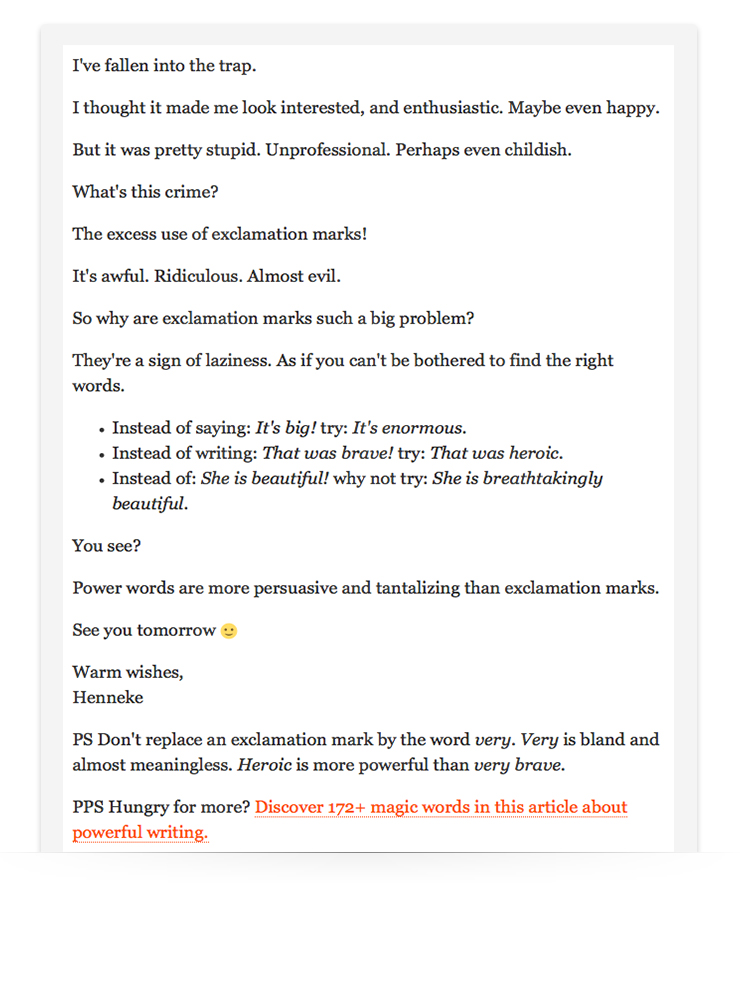 The Multimedia Course Perhaps you have educational content in different formats, like video, audio, or long-form blog articles. If you plan to deliver your course content using different mediums, simply use email to direct the user to a video, audio, or article on your website, or another service (like YouTube.) Here’s an example from Donald Miller of how an email might look using this style:
The Multimedia Course Perhaps you have educational content in different formats, like video, audio, or long-form blog articles. If you plan to deliver your course content using different mediums, simply use email to direct the user to a video, audio, or article on your website, or another service (like YouTube.) Here’s an example from Donald Miller of how an email might look using this style: 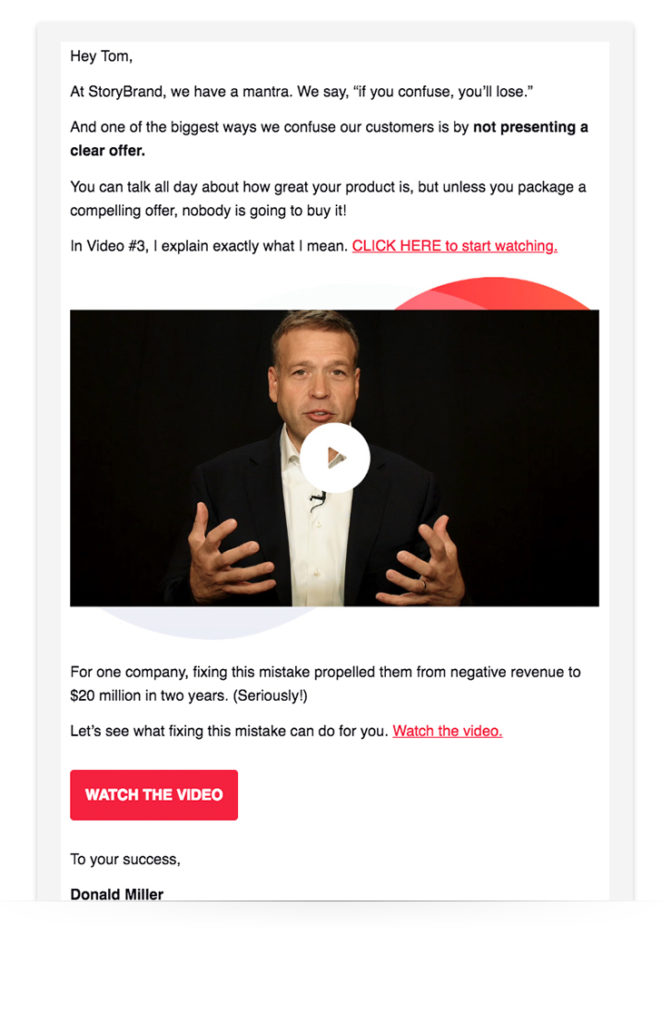 Drive your subscribers to take action No matter what format or tone your course takes, it should definitely be actionable. Be sure that your audience has a clear call-to-action to apply what they’re learning, interact with you or a larger group, and stay engaged throughout the course.
Drive your subscribers to take action No matter what format or tone your course takes, it should definitely be actionable. Be sure that your audience has a clear call-to-action to apply what they’re learning, interact with you or a larger group, and stay engaged throughout the course.
Creating an awesome email challenge
Crafting an email challenge can be a bit easier than a course. It requires less educational content. But you still need a pitch… Challenges are all about transformation. At the end of a challenge, your subscribers should be in an improved state. Your challenge transports them from A to B — from unhealthy to fit, from novice to pro, from start-up to profitable. To successfully attract email subscribers to accept your challenge, you need to pitch that transformation. Craft a short statement that explains the beginning and end state your subscribers will move from if they take you up on your challenge. Here are a few examples:- Launch your own successful food blog in just 7 days!
- 10x your email list with this 30-day challenge!
- Drop 2 sizes in 60 days!
- Include numbers in your subject line to let your audience know where they are in the overall challenge (i.e. Day 1, Challenge 1, Task 1)
- Offer a teaser of how much effort each challenge might require to encourage subscribers to carve out time to complete (i.e. 20 minutes to complete.)
- Don’t let your tribe feel lost. Link to other resources, an online community, or your contact info to encourage them to keep moving forward.
Step Two: Building your automated campaign
Delivering your automated course or challenge emails with AWeber is as easy as it gets. There are just a few steps to upload your draft emails from Google Docs or Microsoft Word (or pen and paper, if that’s how you roll) to an automated sequence — or campaign — inside AWeber. (Haven't tried AWeber yet? Use this link and try AWeber for 30 days.)Designing your emails
Don’t let designing your emails slow you down! There are hundreds of template designs to choose from, so how do you know which one is right for your course or challenge? all that choice might have you questioning which one is right for you. Pro tip: the best design for courses and challenges are as little design as possible. You want your automated emails to feel personal, like a direct message someone might send from Gmail. There are a few stationary style templates in AWeber that will help you send simple personal emails. These will enable you to focus on your message and on building a strong relationship with your subscribers, rather than get distracted with images and formatting options. Here’s an example: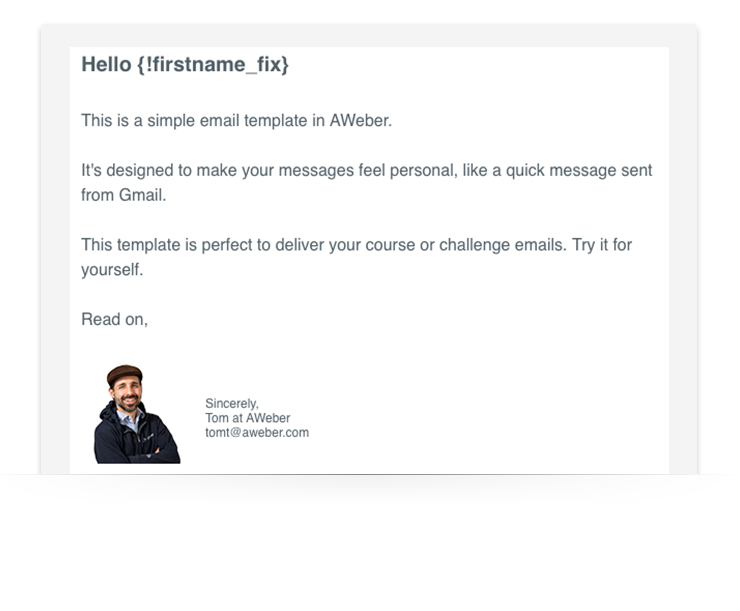 When you simplify your email design, you can build your drafts in minutes rather than hours. Simply transfer your email content into your new template using AWeber’s Drag and Drop Email Builder. Add any logos, images, video thumbnails, or links, and you’re set to begin building your automated campaign.
When you simplify your email design, you can build your drafts in minutes rather than hours. Simply transfer your email content into your new template using AWeber’s Drag and Drop Email Builder. Add any logos, images, video thumbnails, or links, and you’re set to begin building your automated campaign.
Creating your automated campaign
Head on over to Campaigns in AWeber. Just click the Campaigns link in the Messages dropdown. Create a new campaign and choose “On Subscribe” as the trigger, this will deliver your automated emails to all new subscribers. Now, just drag and drop your messages and wait times (the time in between each message.) If you want to send a 30-day challenge with one email being sent each week for 4 weeks, simply drag in four messages with a one-week wait time in between. If you want to send a 7-day email course, drag in seven messages with a one-day wait time in between. Here’s an example: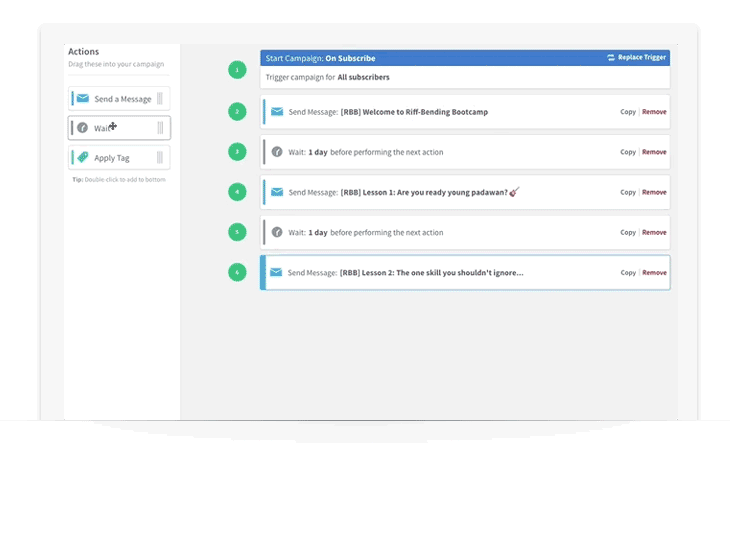 When you’re ready, save and activate your campaign. That’s it! Any new subscribers to this email list will immediately be enrolled into your automated email course or challenge.
When you’re ready, save and activate your campaign. That’s it! Any new subscribers to this email list will immediately be enrolled into your automated email course or challenge.
Step Three: Attracting Subscribers
Once your course or challenge is live, it’s time to attract the right subscribers to join. Focus on these four elements to build a high-converting incentive: signup form, traffic, visibility, and value. Let’s dive into each element!Create your signup form
Your signup form is the entry-point to your course or challenge. This is the form that people will fill out to sign up! To encourage sign ups, you want to make sure your form copy (the actual words describing your course/challenge) is clear and compelling. Be sure the design fits your brand, and it’s easy for anyone to fill it out and submit. Related post: How to Create Amazing Photos for Your Emails on Zero Budget This means you should limit your form to just a few fields, like name and email. Asking for too many details up front might decrease the number of people that actually fill it out. When crafting your form, focus on the pitch you drafted earlier. What’s the value that your course provides, or the transformation that your challenge promises. Here's a few great examples (from Henneke and Pete from Do You Even Blog):
 There are many best practices to pull from these. Some use color to highlight key words and value propositions. Others use images to showcase yourself as the instructor, or a happy student with a positive end result. As your list grows, use social proof to show new visitors that others have found success after opting-in. Social proof is evidence from a real user that your course or challenge worked. This could be a statement like: “Join the 4,000 subscribers that [did the thing your course or challenge promises.]” This could also include course reviews, quotes, or photos from your fans. Another important element of your form is the call-to-action, or CTA. Related post: 8 Ways to Improve Your Call-to-Action Copy to Get More Subscribers Many forms simply state “subscribe” or “sign-up,” which is a bit dull. If you want your future subscribers to be as excited about your course or challenge as you are, dial up the tone of your call-to-action! Here's a good example from Simple Green Smoothies:
There are many best practices to pull from these. Some use color to highlight key words and value propositions. Others use images to showcase yourself as the instructor, or a happy student with a positive end result. As your list grows, use social proof to show new visitors that others have found success after opting-in. Social proof is evidence from a real user that your course or challenge worked. This could be a statement like: “Join the 4,000 subscribers that [did the thing your course or challenge promises.]” This could also include course reviews, quotes, or photos from your fans. Another important element of your form is the call-to-action, or CTA. Related post: 8 Ways to Improve Your Call-to-Action Copy to Get More Subscribers Many forms simply state “subscribe” or “sign-up,” which is a bit dull. If you want your future subscribers to be as excited about your course or challenge as you are, dial up the tone of your call-to-action! Here's a good example from Simple Green Smoothies: 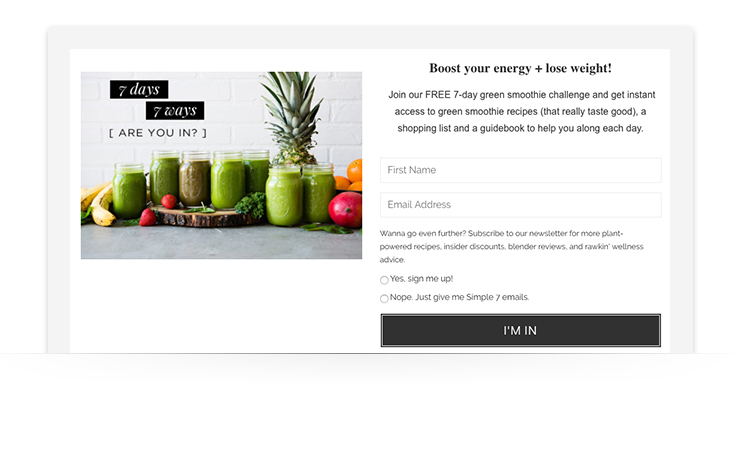 You can easily create a form in AWeber, or use a third-party form tool, like OptinMonster, or a form Wordpress plugin. Don’t have a website? You can also host a signup form with AWeber and we’ll give you a link to share.
You can easily create a form in AWeber, or use a third-party form tool, like OptinMonster, or a form Wordpress plugin. Don’t have a website? You can also host a signup form with AWeber and we’ll give you a link to share.
Drive traffic to your form
The best form in the world won’t generate sign ups if no one sees it! Getting people to see your course or challenge requires traffic. You can think of web traffic as you would real traffic. There are a lot of vehicles potentially driving to your website or sign up form. They can arrive at that destination through a variety of “on-ramps.” These “on-ramps” are typically referred to as channels. These could be Google searches, paid ads, social posts, blog articles, YouTube videos, or even a billboard or radio ad. There are a variety of ways to tell people who you are, what you do, why you do it, and where to go to learn more (your website or signup form). Many marketing channels are free (like posting on Pinterest, or optimizing your content for Google,) just some time and effort, while others might require a small budget, like running a paid Facebook ad campaign. One of the best ways to drive paid or organic traffic to your form or website is to publish relevant content. This can be written, audio, or video content. You can start a blog, podcast, or YouTube series, which might require a lot of effort if you don’t have one of those things already. An alternative to this is guest posting on other people’s blogs or appearing on other people’s podcasts. You can also publish content on public networks like Medium.com. We published a great article sharing 6 ways to get more website traffic that’s super helpful.Increase your form’s visibility
Here’s the reality: Your sign up form won’t do much good at the very bottom of your website. Position your sign up form where people are most likely to see it. This could be in the middle of a popular blog article, or at the top of your site. You might also experiment with pop-up or slide-in forms that appear after your visitors are on your site for a few seconds.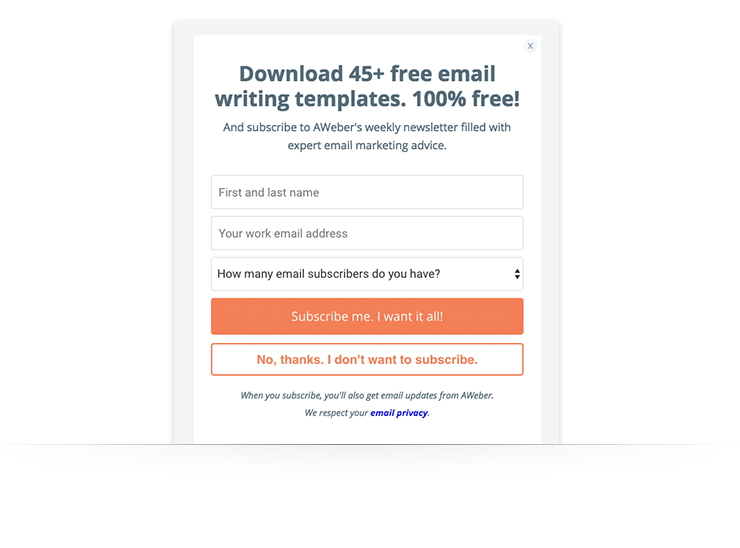 Your form should be working for you, not against you. Here are more examples of forms to provide some inspiration.
Your form should be working for you, not against you. Here are more examples of forms to provide some inspiration.
Promote the value
Your subscribers are going to ask, “What’s in it for me?” WIIFM! Be sure your incentive clearly answers this questions. If you have a challenge, appeal to their desire to improve themselves. If you have a course, stress the value of gaining advanced knowledge or a new skill. Not everyone is willing to share their email address if the value they’ll receive isn’t clear. Make sure your visitors are left thinking, “How could I not sign up!?” Remember, attracting users to your course or challenge takes time. Focus on your form, traffic, visibility, and value and you’ll give your content the best chance to be seen!Step Four: Converting participants to paying customers
Alright, the course or challenge is built, form is functional, people are joining, lives are changing… what’s next? In this final step, we’ll take a look at how to convert your new subscribers into paying customers. Before you can make a sale, you must have something to sell. Related: The Beginner's Guide to Making Money with Email Marketing Here are two quick options to put you on the path to profitability.Option 1: Develop a paid solution to a relevant problem
If you are already an established business, you likely offer a product or service. This product or service should ideally solve a problem that is relevant to the problem your course or challenge addresses. For example, if you produce fitness content or run a fitness challenge, you may sell paid fitness videos or home gym equipment. Maybe you have customized workout plans that can be sold digitally, or you have a gym or training service that caters to local customers. Or if you produce a mini-email course on a specific topic, you might have a more robust paid course offering, a book, or one-on-one consultation sessions that you can sell. Here are a few common products you might consider developing:- A premium email course, delivered by AWeber
- A digital course, hosted on Thinkific or Teachable
- A physical book, sold in stores or on Amazon.com
- Digital products (like a PDF or eBook)
- A physical product, sold through an eCommerce store
- Consultation services via Skype or in-person
- Because you developed your own paid product or service, you retain the revenue!
- Your happy email subscribers are now more invested in you and your brand after purchasing one of your products or services.
- Expanding your product and service line offers future opportunities to make more revenue.
- If you don’t already have a product or service, you’ll have to develop one, which can require time, money, and resources.
- If you sell physical goods, you’ll have to handle production, fulfilment and delivery, customer service, and returns. If you sell a physical service, be prepared to invest your time and manage administrative tasks and customer service.
- If you sell a single one-time purchase product or service, you’ll always need to find and convert new customers, since your existing customers don’t have a reason to be repeat buyers.
Option 2: Sell someone else’s products or services
Okay, so maybe you don’t have an established business, service, or product. You might not have the time and energy to invest in starting from scratch. Here’s the solution: You can promote someone else’s products or services to your new audience and earn money for any sales you might refer. This is typically called an affiliate, partner, or referral program. Not all products or services will offer one, and you’ll have to sign up and agree to the terms of the provider if you want to pursue this route. The key to successfully earning revenue as an affiliate or partner is to make sure that the products and services you promote are super relevant. What you promote should speak to the same pain points and needs that your course or challenge addresses. For example, if you are doing a 30-day fitness challenge, you may consider promoting health food or nutritional supplements. Perhaps your favorite paid workout programs have a referral program — a perfect “next step” to promote to anyone that reaches the end of your challenge. You may have a mini-course on learning a new computer skill, like digital photography or video editing. Promoting the physical products you’d recommend using — like a camera, tripod, light kit, or software, can also be very relevant and rewarding, as you gain the trust of your new subscribers. Pros:- You don’t have to develop any products or services. You can spend more time building your audience and less time building a new business.
- You don’t have to worry about product or service fulfilment, or customer support. You still need to stand behind the products you promote, so make sure the brands you partner with treat your subscribers’ with exceptional care.
- Your income is mostly passive! If you build a successful magnetic course or challenge that promotes someone else’s products or services, your revenue generated is mostly passive, meaning you’ll do the upfront work of setting things up, and email automation will keep things running.
- As an affiliate or partner, you only take home a slice of the total sale, as the majority will go to the seller.
- You don’t have a lot of control over your revenue stream. You’re subject to the terms of the partner, who can adjust their payout percentage and frequency, or even cancel their program altogether.
- You’re sharing your audience with another brand. By promoting someone else, you’re missing an opportunity to serve your core audience in a meaningful way and continue to deliver value to your subscribers.
How to convert your subscribers into paying customers!
Regardless of which option you choose to monetize your efforts, you’ll have to successfully lead your subscribers to a point of sale. Here are two tips to help you sell more through your course or challenge. Conversion tip #1: Tease the problem. A strong conversion strategy is to always tease the problem, or shine a light on what your audience might be struggling with, even as your course or challenge moves them towards the solution. Related: How to Find Your Customers' Pain Points Your content should provide real value, solve real problems, and transform customers into a better version of themselves, but the result should never be the final destination. Even after a 30-day fitness challenge, or a mini-course to learn a skill, your subscriber will still need to maintain their health, or practice their skill. Or, maybe take the leap and seek out the next level of their development. Paid content, products, or services can help your subscribers continue to move forward. By teasing the problem, your paid solution is always the logical next step. Conversion tip #2: Show, don’t tell. It’s easy to tell your subscribers that a product or service could solve their problems or change their world. But keep in mind that your subscribers are likely asking themselves these questions:- “How much does it cost? Is it worth the money?”
- “How complicated is it? Can I do it?”
- “Do I need it? Can I be successful without it?”
- “What are other people saying?”
Never stop learning.
Go forth and build your online course or challenge, but be sure to keep on learning what's working as marketing continues to evolve. Want to continue growing as an email marketer? Subscribe to our weekly newsletter FWD: Thinking to get the latest and greatest content in your inbox. From attracting new subscribers to sending emails that just work, we’ll help you crush your business and marketing goals.Get started with AWeber
AWeber is the perfect platform to deliver your online course or challenge. Easily match your brand with one of our customizable email templates, and build your automated campaigns with easy using our drag-and-drop Campaign editor. Need a hand? Our email experts are ready to help 24 hours a day, 7 days a week. Get started with AWeber today, free for 30 days!The post How To Create Your First Email Course or Email Challenge appeared first on Email Marketing Tips.
from Email Marketing Tips http://bit.ly/2DXKNeb
via IFTTT